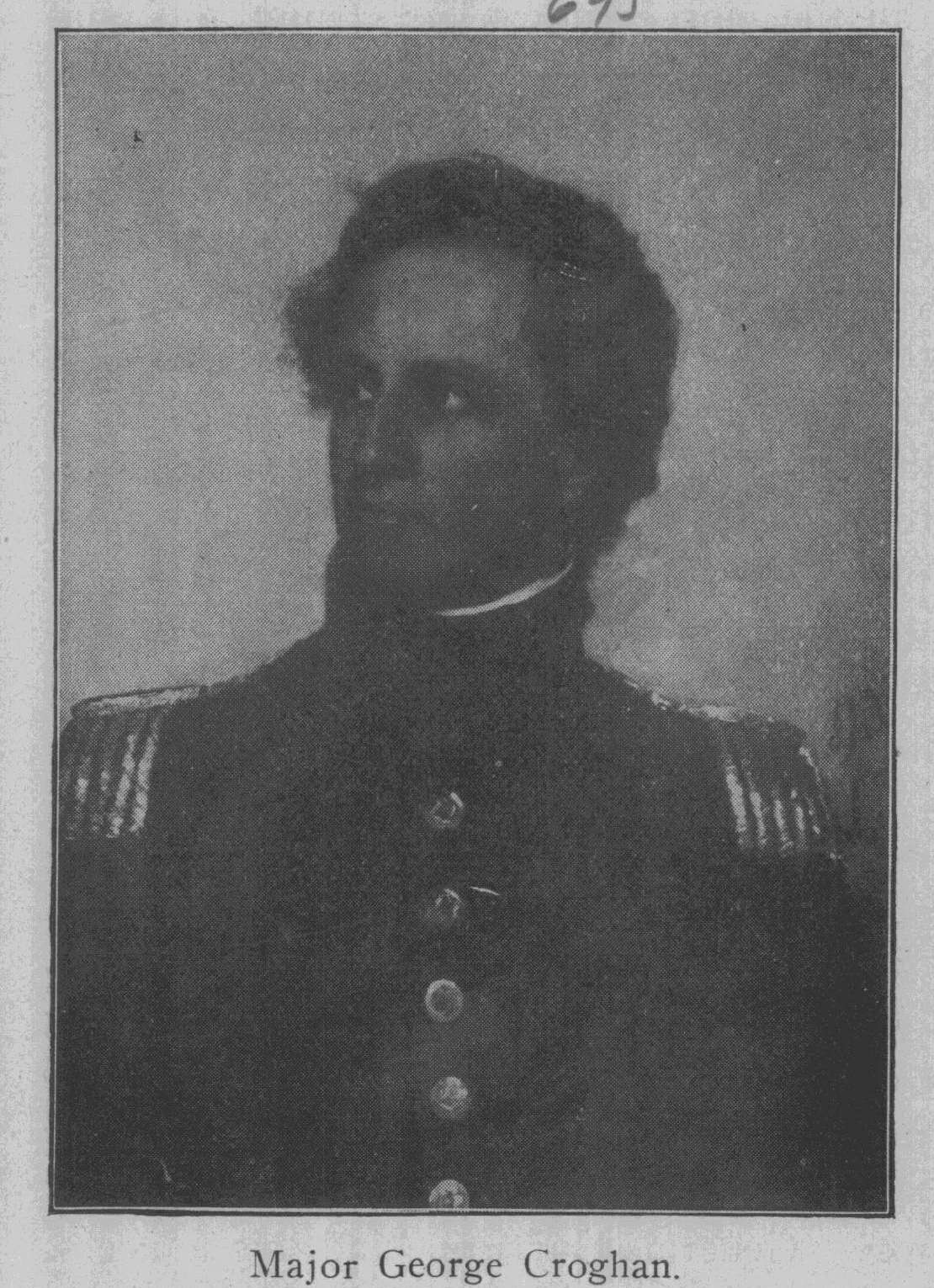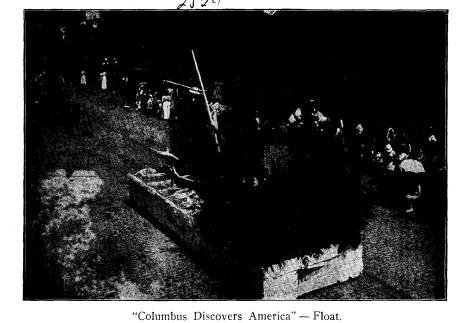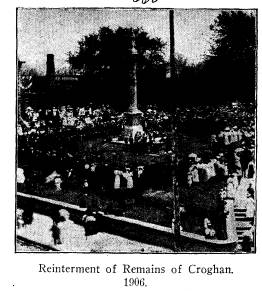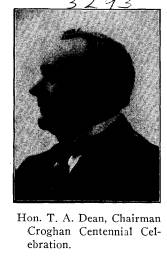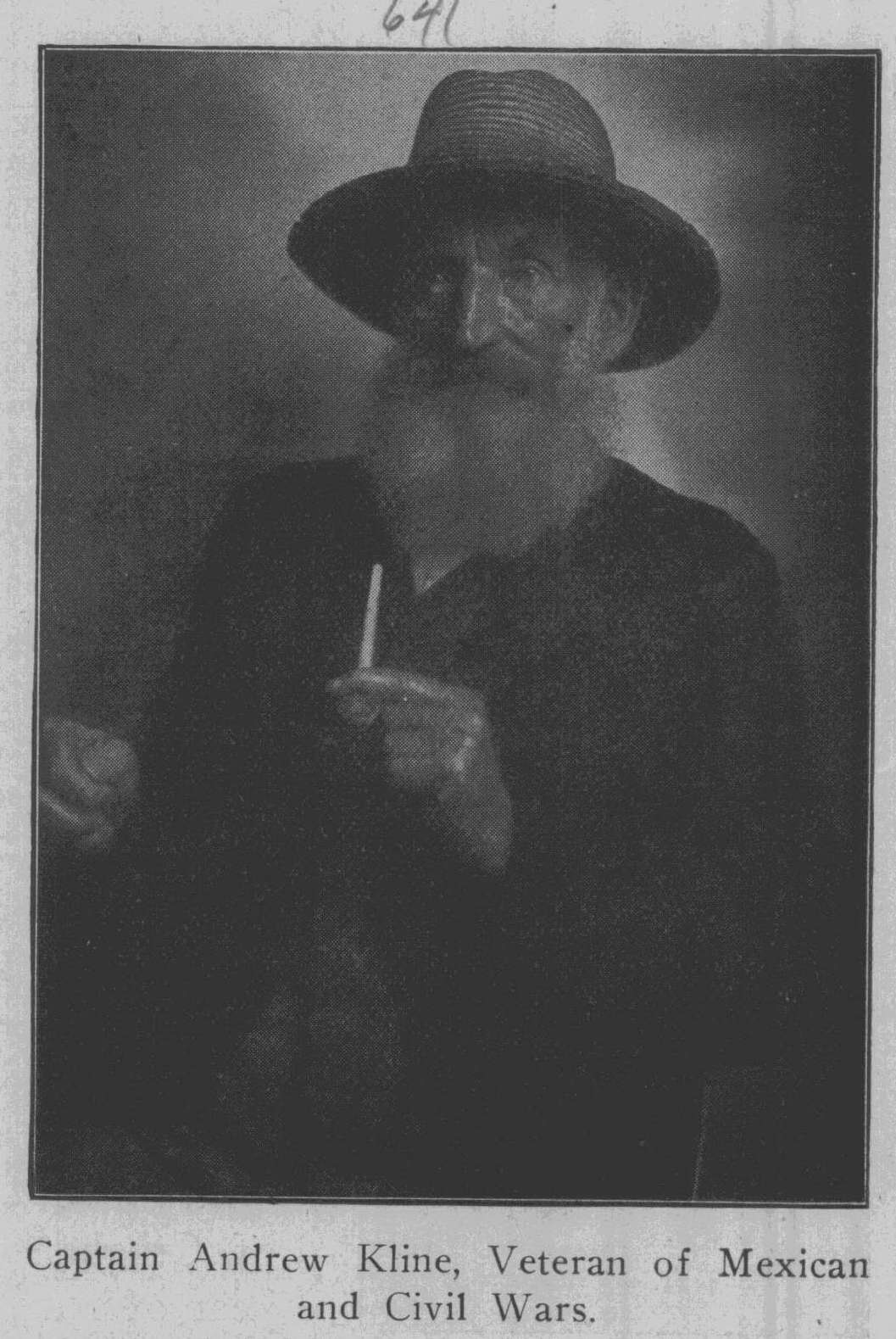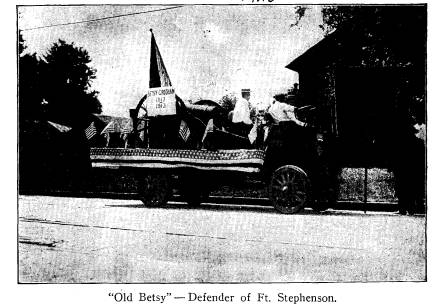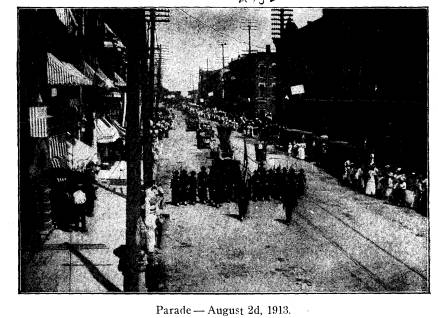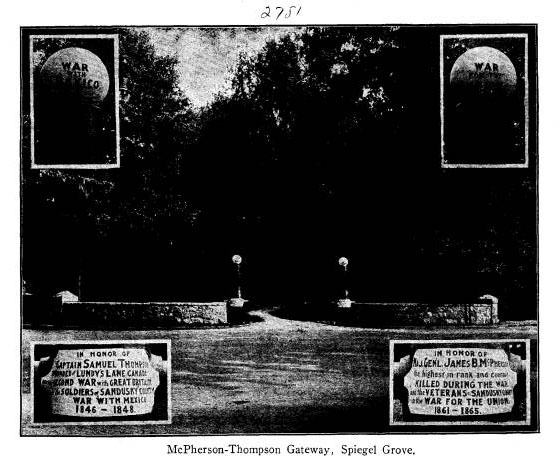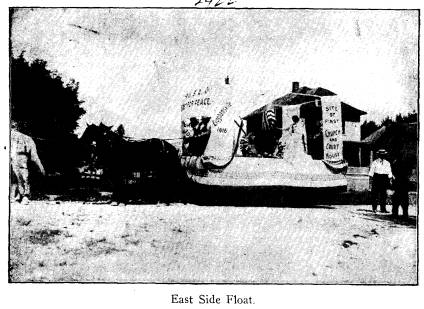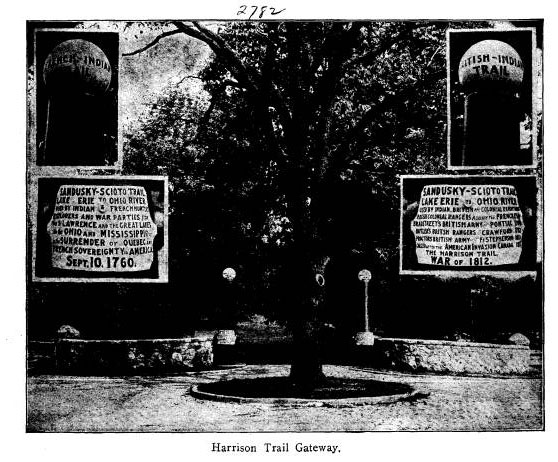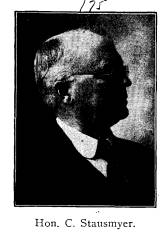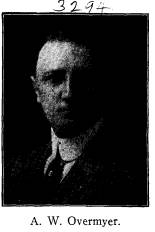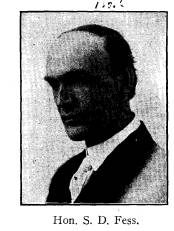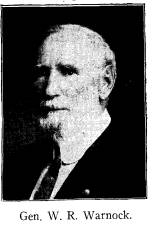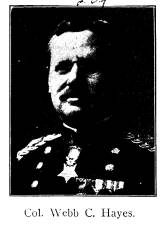Ohio History Journal
|
OHIO Archaeological and Historical PUBLICATIONS.
THE CENTENNIAL OF CROGHAN'S VICTORY.
BY LUCY ELLIOT KEELER. The historic and picturesque little city of Fremont, Ohio, celebrated on the second of August, the centenary of Croghan's Victory, the one successful land battle on American soil of the War of 1812. Fort Stephenson, on the banks of Sandusky River, at the village then known as Lower Sandusky, was gar- |
|
|
|
Vol. XXIII-]. 1 |
2 Ohio Arch. and Hist. Society Publications.
which proved the turning point in the
War of 1812. For this
exploit he was breveted
Lieutenant-Colonel by the President of
the United States; Congress awarded him
a medal of honor, one
of nine; and to his officers six swords
of the fifteen ever so given.
"The defense of Fort
Stephenson," said General Sherman in 1885,
"by Croghan and his gallant little
band, was the necessary pre-
cursor to Perry's Victory on the Lake
and General Harrison's
triumphant victory at the Battle of the
Thames."
A coincidence of history is that
Croghan's Victory, which
in 1813 so materially affected the real
independence of the
United States, occurred on August 2d,
the day in 1776 on which
the Declaration of Independence was
signed. No more curious
error exists in the popular conception
of American History than
that the Declaration was signed on the
4th of July. Independ-
ence was declared, as all the world
knows, bells rung and bon-
fires lighted on the 4th; and within a
few days thereafter a few
copies of the Declaration, signed by the
president and secretary
of the Congress were published. Not
until August 2d, however,
was the Declaration, engrossed on
parchment, signed by fifty-
three members of Congress then
present. Subsequently the
other three affixed their signature,
completing the fifty-six
signers of our great document.
For many years the city of Fremont had
anticipated as an
anniversary to celebrate the centennial
of Croghan's Victory, and
the fulfilment of this plan was a worthy
culmination of a series
of events in the years between. The
first celebration of the day
may be called anticipatory. On the 4th
of July preceding the
battle of Fort Stephenson, Col. Richard
M. Johnson, "the man
who killed Tecumseh," who was here
with his mounted regi-
ment of Kentucky volunteers, joined with
the garrison at the
fort to celebrate Independence day
"with harmony and enthusi-
asm. * * * Colonel Johnson delivered an
address, toasts were
drunk, cheered by the shouts of the men
and the firing of small
arms and discharge of a six-pounder from
the Fort."
The exhilarating news of Perry's Victory
on Lake Erie set
Fort Stephenson, Fort Seneca and Harrison's
Army in an up-
roar of tumultuous joy. General Harrison
and his officers,
among whom were Governor Shelby of
Kentucky and Governor
The Centennial of Croghan's
Victory. 3
Meigs of Ohio, proceeded to Lower
Sandusky and issued orders
for the movement for the recapture of
Detroit and the invasion
of Canada, by way of old Fort Sandoski
of 1745 and the islands
of Lake Erie.
The first formal celebration of the
anniversary of the battle
was that of 1839, planned by a committee
of twenty-one promi-
nent citizens of the village. "A
splendid ox was neatly and
admirably roasted whole, after the best
Kentucky style, sup-
ported by several smaller animals cooked
in the same manner.
The dinner was served under a capacious
arbor prepared on the
hill in full sight and within a few rods
of the old Fort." After
the barbecue dinner the company
adjourned to the Fort, a few
relics of which still remained there,
where the Hon. Eleutheros
Cooke, of Sandusky, delivered an able
address. Letters were
received from General Harrison, Henry
Clay, Vice-President
Richard M. Johnson, Governor Shannon,
etc., and the following
letter from Croghan was read aloud:
"ST. Louis, Mo., 26th July, 1839.
GENTLEMEN: I have the honor to receive
your letter of the 8th,
inviting me, on the part of the citizens
of Lower Sandusky, to be pres-
ent with them in the coming anniversary
of the defence of Fort Steph-
enson. It is with regret that I am, on
account of official duties, unable
to comply with your flattering
invitation. In communicating this, my
reply, I cannot forbear to acknowledge
with deep gratitude, the honor
you confer. To have been with those
gallant men who served with me
on the occasion alluded to, permitted by
a kind Providence to perform
a public duty which has been deemed
worthy of a special notice by my
fellow-citizens, is a source of high
gratification, brightened too by the
reflection that the scene of conflict is
now, by the enterprise and industry
of your people, the home of a thriving
and intelligent community.
I beg to offer to you, gentlemen, and
through you to the citizens
of Lower Sandusky, my warmest thanks for
the remembrance which you
have so flatteringly expressed.
With every feeling of respect and
gratitude
I am yours,
G. CROGHAN."
In the volunteers sent out from Sandusky
county in the
War with Mexico, Capt. E. D. Bradley's
company of the First
Ohio Infantry, and Captain Thompson's
company of the Fourth
Ohio Infantry, each had the honor of
being inspected by the
4 Ohio Arch. and Hist. Society Publications.
then Colonel and Inspector General of
the army, George
Croghan, who took special pleasure in
meeting men from the
scene of his famous victory.
Of the committee of arrangements for
celebrating Croghan
Day of 1852, Col. Wm. E. Haynes alone
survives. Fully six
thousand persons were present. A salute
of twenty-one guns
from "Old Betsy Croghan"
opened the exercises. In the pro-
cession were the Fort Ball Artillery and
Band, the Washington
Guards and the Tiffin Hook and Ladder
Company, all of Tiffin;
the latter with Wm. H. Gibson, later
Brigadier General of Volun-
teers; W. W. Armstrong, later Secretary
of State and long editor
of the Cleveland Plain Dealer; and John
C. Lee, later Brigadier
General and Lieut. Governor of Ohio, who
pulled the hand engine
and hose cart. The Fremont Artillery,
Captain Isaac Swank
with the cannon "Betsy
Croghan," followed. Wm. H. Gibson,
the Patrick Henry of the nineteenth
century, and Homer Ev-
erett delivered eloquent addresses. Gen.
John Bell of the Mich-
igan War was president of the day.
In 1858, the celebration was managed by
the "Firemen of
the Village," through a committee
of seven citizens, who invited
the Hon. Elisha Whittlesey to deliver
the address. He said:
"Some who are present knew the site
of this beautiful village
when it was a dilapidated, abandoned
Indian town, approached
with difficulty by civilized men by
reason of the thick forests
and deep swamps. It was so remote from
the settlements in
Pennsylvania, which then bordered
civilization, and so em-
bosomed in the wilderness, that to the
Indians it was only a
city of refuge. For a long period they
committed depredations
on the lives and property of the
resolute and hardy settlers. In
some instances whole families were
murdered; but most fre-
quently women and children were captured
and borne off with
celerity to escape pursuit. When the
Indians arrived with their
captives, stolen horses and plunder at
Lower Sandusky they
were safe. From this spot in former
years, many anguished
sighs ascended to Heaven from distressed
mothers who stopped
here for a short period on their way to
Detroit, or other places
of captivity, while their savage captors
held pow-wows of ex-
ultation. Many a mother's heart has bled
here from having seen
The Centennial of Croghan's
Victory. 5
the head of a beloved child broken
against a tree, for no other
reason than that its captor thought the
child a burden or im-
peded his flight. I know of no place in
the West where more
thrilling events have taken place than
at Lower Sandusky where
we are now. When I was here last season
and had the pleasure
to converse with our esteemed friend S.
Birchard, Esq., my effort
was to impress upon his mind the
importance of forming a His-
torical Society here to collect and
perpetuate the incidents of
this place, extending far back into the
history of the Wyandot
tribe. Lower Sandusky was the theatre
during the War of 1812
of one of the greatest military
achievements of the age, when
the number and condition of the force
under Major Croghan
are considered. If forty-five years ago
this day Major Croghan
had not been adequate to his condition
and command, and Gen-
eral Proctor had captured this post, can
your minds depict the
sufferings and terrific scenes that
would have followed?"
Cassius M. Clay was the orator of the
day at the Croghan
celebration of 1860. "At six
o'clock Captain Parrish brought
out Old Betsy and fired a salute of
thirteen rounds. Soon after-
ward the people of the county began to
pour in. The Cleveland
and Toledo Railway brought a large
delegation from the west
and from all the towns to the east. The
steamers Bonnie Boat,
Swan and Island Queen arrived from Sandusky and
Plaster
Bed bringing hundreds more."
Every 2d of August thereafter had some
recognition from
the townspeople, but in 1877 the
long-planned celebration was
postponed a few weeks that Fremont's
most distinguished citizen,
then President of the United States,
might be present to assist
in the laying of the cornerstone of the
City Hall on the north-
east corner of Fort Stephenson Park, the
ceremonies being con-
ducted by G. A. Woodward, Grand Master
Mason Lodge of
Ohio, after which President Hayes closed
the ceremonies by
saying: "Ladies, gentlemen, and
fellow-citizens: For the pur-
poses of the city of Fremont we erect
here on this ground made
illustrious by the victory of Col.
Croghan at his gallant combat
with the British, a City Hall. The
cornerstone has now been
laid. The ceremonies in connection with
it are now ended and
I am requested to announce that the
further public exercises of
|
6 Ohio Arch. and Hist. Society Publications. the day will take place immediately after dinner at the park in front of the Court House." At the exercises in the afternoon, President Hayes pre- sided, and after the orator of the day, Major William Mc- Kinley, 23d Ohio, had delivered his address, introduced Chief Justice Waite, Secretary of War McCrary, Senator Stanley Matthews, Lt. Gen. Philip H. Sheridan, U. S. A., and former Generals W. S. Rosecrans, J. D. Cox, S. S. Carroll, I. H. Duval, |
|
|
|
F. H. Devol, E. P. Scammon, R. P. Kennedy, and our own Wm. H. Gibson and R. P. Buckland. On Croghan Day, 1885, the Sandusky County Soldiers' Monument in Fort Stephenson Park, was unveiled, with Gen. Rutherford B. Hayes, late President of the United States, as presiding officer. In his address we find: "Intimately associ- ated with Croghan's Victory are the favorite names of the pioneer history of the West. General Harrison, Commodore Perry, General Cass, General McArthur, Col. Rich. M. Johnson, |
The Centennial of Croghan's
Victory. 7
Governor Meigs, Governor Tiffin and a
long list of other able
men whose names were household words in
the homes of the
first settlers of this region, were all
closely identified with the
military events which hinged upon the
brilliant victory which
was gained here, and which decided the
struggle for the vast and
noble territory which is tributary to
the Great Lakes of the
Northwest. That I do not overstate the importance of the
brilliant event which gives a place in
history to our little city of
Fremont, I read you a few paragraphs from letters by Col.
Chas. Whittlesey of Cleveland and by
General Sherman. With
an honorable record as a Union soldier,
Colonel Whittlesey is
still more widely known as the
indefatigable and learned local
historian of this part of our country.
He says:
"Your polite invitation brings in
review a number of historical
events connected with your city, that
have occurred during the past
century. The rapids at Lower Sandusky,
where Fremont now is, put a
stop to the expedition of Colonel
Bradstreet in October 1764, on its way
to join Colonel Bouquet at the forks of
the Muskingum. During the
war of the Revolution, many of the
expeditions of the British and their
Indian allies passed up the Sandusky
river, to attack the frontier settle-
ments. In the fall of 1781 the Moravian
Missions on the Tuscarawas
under Zeisberger, were forced away from
their posts to the towns on the
Sandusky, and thence to Detroit. English
and Indian war parties passed
up the river to join in the battle
against Colonel Crawford near Upper
Sandusky, in June 1782. The first
Protestant Mission among the Wyan-
dots and the first United States Agency,
were located at the lower rapids
in 1803 and 1808, their buildings
forming part of the fort constructed
in 1812. The first company drafted on
the Reserve in April 1812, under
Capt. John Campbell was ordered there,
and assisted in completing the
Fort. But all these interesting events
culminated in the unparalleled
discomfiture of the British and Indians
in August, 1813, by a young
Major of Kentucky, acting against
orders. Nothing can be more appro-
priate than the celebration of a defence
so brilliant and complete and the
erection of a suitable monument to fix
the spot forever."
General Sherman writing to the Committee
points out in
his terse way the strategic value of the
triumphant defence of
Fort Stephenson. He says:
"The defence of Fort Stephenson, by
Croghan and his gallant little
band, was the necessary precursor to
Perry's victory on the Lake, and
of General Harrison's triumphant victory
at the battle of the Thames.
These assured to our immediate ancestors
the mastery of the Great
|
8 Ohio Arch. and Hist. Society Publications.
West, and from that day to this the west has been the bulwark of this nation." Croghan Day, 1903, was made notable by the presence as orator of Mr. Charles R. Williams of Indianapolis, who de- livered an able address on Croghan before the George Croghan Chapter of Daughters of the American Revolution, assembled under the fine old Reunion Oaks at Spiegel Grove. The Presi- dent General of the D. A. R., Mrs. Chas. W. Fairbanks, was an honored guest and speaker; and the D. A. R. chapter unveiled a boulder tablet to Croghan on the old Fort. The ceremonies incident to the reinterment of John Paul Jones at Annapolis recalled to the patriotic Colonel Webb C. |
|
|
|
which secured the presence of Chas. W. Fairbanks, Vice-Presi- dent of the United States, Gov. A. L. Harris and staff, and a brigade of the Ohio National Guard under command of Brig. General McMaken. A procession of children from the public and parochial schools followed the military division, and the remains were taken from the High school (where they had lain in state on the site of the burial place of the British officers killed in |
|
The Centennial of Croghan's Victory. 9
the assault) and conveyed to the foot of the monument on the fort. The grave was covered with a large block of Quincy gran- ite bearing this inscription: George Croghan Major 17th U. S. Infantry, Defender of Fort Stephenson, August 1st and 2d, 1813. Born Locust Grove, Ky., Nov. 15, 1791. Died New Orleans, La., Jan. 8, 1849, Colonel Inspector General United States Army. Remains removed from Croghan Family Burying Ground, Locust Grove, Ky., August 2, 1906.
The principal address was delivered by the Hon. S. D. Dodge of Cleveland, followed by remarks by Vice-President Fairbanks, Governor Harris and Secretary Randall of the Ohio Archaeological and Historical Society. A public reception was |
|
|
|
struction to the river towns in Ohio, those along the old Sandusky- Scioto waterways of the Indians suffering not the least. The centennial committees of Fremont at once turned their |
|
10 Ohio Arch. and Hist. Society Publications.
entire attention to the relief of the distressed citizens and by common consent the centennial celebration was abandoned. Just prior to the Fourth of July, however, the decision was suddenly made not to let the centennial of Croghan's Defence of Fort Stephenson which saved the State from the invasion of British and Indians go entirely unrecognized. A resolution at the an- nual meeting of the Ohio Archaeological and Historical Society |
|
|
|
Guard, under command of Lieut.-Col. McQuigg of Cleve- land, and the presence of Congressman Simeon D. Fess, President of Antioch College and orator of the day; and Gen. W. R. Warnock, commander of the Department of Ohio, G. A. R.; and H. C. Kuntz, Grand Master I. O. O. F. of Ohio;- the officers of the Ohio Archaeological and Historical Society now being classed as citizens of Fremont,-the celebration was |
The Centennial of Croghan's Victory. 11
purely local. A distinct effort was made
to avoid decorations
other than the national flag of
forty-eight stars and to keep
expenses to the minimum with the
exception of the display of
fireworks and the Venetian Night on
Sandusky river and the
reproduction of Fort Stephenson on
Brady's Island-the island
made famous by the scout Brady who, to
secure information
under direct orders from Washington,
secreted himself on this
island to determine the disposition of
the Indians and their pos-
sible warlike intentions during the last
year of the Revolutionary
War.
The pageant of the morning in which over
two thousand
persons participated, took the form of a
procession of military
and fraternal organizations and of
historical and industrial floats.
The formation of the parade took place
on the east side, Cro-
ghansville, Fremont's original site.
Objects and floats that drew
special applause were "Old
Betsy," Croghan's historic cannon,
guarded by members of the G. A. R.;
Captain Kline, a veteran
of the Mexican and the Civil Wars,
driving in President Hayes'
old barouche; and the Port Clinton Life
Savers who did such
heroic rescue work during the recent
Fremont flood. The Pres-
byterian float showed the Rev. Joseph
Badger, pioneer Presby-
terian missionary to this region,
sitting by his cabin which about
1807 he built on the knoll where six
years later the battle was
fought. Badger, a Revolutionary soldier,
who fought both at Lex-
ington and Bunker Hill, was educated in
the family of a president
of Yale, and in the opening year of the
nineteenth century was
sent to Ohio by the Connecticut Foreign
Missionary Society,
becoming the first minister and school
teacher in the Sandusky
country. Knowing the locality perfectly,
he served frequently
as guide as well as brigade chaplain in
Harrison's army in the
war of 1812. He continued his devoted
work as missionary
among the Indians without stated
compensation till 1826 when
he obtained a pension of ninety-six
dollars a year as a Revo-
lutionary soldier. In 1840, during the
famous Harrison presi-
dential campaign, the Whigs of
northwestern Ohio reached the
convention hall in Columbus, in a
procession half a mile long,
with a facsimile of Fort Meigs at its
head. This was built under
the supervision of Elder Badger, then
eighty years old, who
|
12 Ohio Arch. and Hist. Society Publications.
rode jauntily upon the fort which he had so valiantly defended. The Badger float was preceded by twenty-two scouts on horses, well armed. The Daughters of the War of 1812 displayed a float representing the log cabin of James and Elizabeth Whit- taker, first permanent white settlers in Ohio. The two young white captives, adopted by the Wyandots, were by them given as a wedding portion a choice tract of land along the river a few miles below Fort Stephenson, in 1781, their first cabin ante- |
|
|
|
dating by several years the settlement at Marietta. More than thirty years later, the British army retreating down the river, after their defeat at Fort Stephenson, stopped at the Whittaker reservation long enough to fire and utterly destroy the old home, warehouse, the government factory and the wharves. They also carried off a handsome silver service which British officers had presented to the Whittakers several years earlier in token of their appreciation of many kindnesses. Mrs. Whittaker had cared for the distinguished Revolutionary officer, Major Nathan Goodale, intimate friend of Rufus Putnam, when as Indian |
|
The Centennial of Croghan's Victory. 13 captive he had been hurried from his home in Marietta, and too ill to travel further was left to die at the Whittaker's. The Whittaker float was followed by the display of the East Side Improvement Association, led by a group of young men on horseback, with a float representing "the city of refuge, 1650." Their banner was inscribed, "site of the first church and court house." This float started at Pine Street where the first court house was located. |
|
|
|
The Daughters of the American Revolution commemorated the Bradstreet Expedition of 1764, to recover the forts taken by Pontiac. Their float was gay with counterfeit presentments of British and Colonial figures, Bradstreet himself; Israel Put- nam, hero of the wolf's den and Bunker Hill; Montresor, the distinguished British, engineer; and Pontiac, who defied them all. Bradstreet's army of 1,400 men came up the Sandusky river in sixty long boats, Lower Sandusky (Fremont) being the westernmost point reached by the expedition. |
|
The Centennial of Croghan's Victory. 15
Methodism harked back to Rev. James Finley, the pioneer preacher, who carried on the notable mission to the Wyandots at Upper Sandusky. Almost a century ago Finley adopted what are considered modern methods of dealing with the Indian on his reservation,-industrial training and land in severalty. The Catholic Knights of Columbus had a beautiful float representing Columbus' Discovery of America. The reviewing stand was erected opposite the McPherson- Thompson Gateway at Spiegel Grove, from which point the |
|
|
|
procession was reviewed by his Honor Mayor Stausmyer and the former Mayors of Fremont; Capt. Andrew Kline, the Chairman of the day, and his representative, City Solicitor Overmyer; the Hon. S. D. Fess, orator of the day; Gen. W. R. Warnock, Com- mander of the Grand Army; Grand Master Kuntz; Pres. G. Frederick Wright and Secy. E. O. Randall and L. P. Schaus, chairman of the Hayes Memorial Building Committee; all of the Ohio Archaeological and Historical Society; and Major Geo. D. Saffarans, Seventeenth U. S. Infantry, as a representative of |
16 Ohio Arch. and Hist.
Society Publications.
the regiment in which the gallant Major
George Croghan was his
predecessor one hundred years ago. On
reaching the reviewing
stand Lieut.-Col. McQuigg, commanding
the battalion of engi-
neers, marched his command into Spiegel
Grove and counter-
marched through the grove over the
Harrison Trail, as Major
Croghan had done on his return from Fort
Seneca, to take com-
mand again of Fort Stephenson the
evening before the battle. The
remaining division counter-marched after
passing the reviewing
stand, and returning east on Croghan
Street was disbanded at
Fort Stephenson. The brief exercises of
dedication and accept-
ance of the McPherson-Thompson gateway,
erected in honor
of the soldiers of Sandusky County who
fought in the war with
Mexico, and in the War for the Union,
consisted of its presenta-
tion by General Warnock, and acceptance
on behalf of the So-
ciety by Secretary Randall, following
which the distinguished
guests were conveyed south along the new
Cleveland Avenue,
on the west side of Spiegel Grove, to
the beautiful Harrison
Trail Gateway at the southern entrance
of the old Sandusky-
Scioto land trail later known as the
Harrison Trail; to the
Buckland gateway the main entrance into
Spiegel Grove some
three-quarters of a mile from Fort
Stephenson. The Harrison
gateway was accepted by President G.
Frederick Wright of the
Archaeological and Historical Society on
behalf of the Society, as
follows:
From the days of Joshua when he placed
memorial stones to mark
the place where the Children of Israel
crossed the Jordan to enter the
Promised Land, until now, patriots have
ever been wont to erect sim-
ilar monuments to mark places of special
historical interest, so that now
as then children shall be led to ask of
their parents, What mean ye by
these stones? thus compelling them to
keep alive the memories of the
past. Fully to answer the questions
stirred by the sight of this im-
pressive and beautiful gateway would
require a longer story than we can
pause to tell on the present occasion.
But we cannot let the occasion
pass without giving a brief summary of
its significance.
For untold ages the native races of
America passed through these
grounds as they traveled to and fro
between Lake Erie and the Ohio
River. A deeply eroded pathway still
bears evidence of the countless
feet that in ages past have trod this
highway. Coming down from the
summit of the hill to the north the
trail led through this gateway to a
spring in the valley, where the weary
travelers could quench their thirst,
The Centennial of Croghan's
Victory. 17
and thence passed onward to the higher
general level from which it had
descended.
As in numerous other instances civilized
man here found that he
could do no better than follow the
Indian trail. A hundred years ago
this very month General William Henry
Harrison was encamped with
a considerable army at Camp Seneca, a
few miles south of here, having
come so far on his way to meet the
British forces that were occupying
the western end of Lake Erie. While
Harrison paused at Fort Seneca
where he could keep in communication
with the forces that were gather-
ing at some distance upon his right and
left flank, Major Croghan won
his famous victory over the British
forces at Fort Stephenson where his
monument is erected in the center of
Fremont. Forthwith scenes were
here enacted that had not been witnessed
before or since. Long lines
of well armed infantry and splendidly
mounted cavalry with their accom-
panying artillery and baggage wagons
moved along this trail, passed
through the area occupied by this
gateway and over the hill beyond, on
its way to old Fort Sandoski and across
Lake Erie to the brilliant victory
of the Thames. A few weeks later the
same warlike host exultant with
victory returned over this trail to
enjoy with their fellow countrymen
the fruits of a lasting peace. The
picture brought up to the imagination
is an inspiring one and should draw to
this spot countless pilgrims de-
siring to be thrilled with the patriotic
emotions which this gateway is
calculated to rouse. The Ohio State
Archaeological and Historical So-
ciety to whom the care of these grounds
has been committed by the
generous donor, Colonel Webb C. Hayes,
now opens this gateway to the
public believing that all who pass
through it will give thanks to Colonel
Hayes for the noble tribute which he
here gives to the defenders of
our country a hundred years ago, that as
they pass on to see the mem-
orials which the state has erected to
his distinguished father General
Rutherford B. Hayes, President of the
United States, they can but still
further appreciate the significance of
these memorial stones.
The three handsome gateways are the gift
of Col. Webb C.
Hayes. Between the Harrison and Buckland
entrances runs the
Harrison Trail, an old, deeply trodden
military road, preserved
as the principal driveway of Spiegel
Grove. It was traversed
by the Jesuit missionaries and the early
war parties with their
Indian allies in their endeavors to
expel the English from the
Ohio country, and later by Harrison's
troops and supplies. Is-
rael Putnam, Daniel Boone, Simon Kenton,
and the Moravian
missionaries passed along this famous
road, as well as all the
principal officers of the War of 1812,
Andrew Jackson alone
excepted: William Henry Harrison;
Richard M Johnson, later
Vol. XXIII-2.
|
The Centennial of Croghan's Victory. 19
Vice President; Lewis Cass, later Postmaster General; Governor Meigs of Ohio, and the venerable Governor Shelby of Kentucky. Fort Stephenson, where the addresses of the day were made, is unique among old forts in preserving its ariginal area, its orig- inal armament and the body of its defender. The speakers' stand was erected near the grave of Croghan, over which "Old Betsy" Croghan's single piece of artillery stands guard. Many dis- tinguished soldiers and statesmen and civilians have through the years paid tribute at Old Betsy's shrine; and like Independence Bell she has made voyages of honor. She is the only one left who saw Croghan in battle and heard the quick orders of those critical days; who faced the oncoming veterans of Wellington's troops and laid many of them to rest about her in the soil of Lower Sandusky. The guests of the Committee and the speakers of the after- noon, together with Major George D. Saffarans of the 17th U. S. Infantry, as the representative of Croghan's old Regiment, and Brig. Gen. W. V. McMaken and Lt. Col. John R. McQuigg, with the officers and their ladies of the battalion of Engineers 0. N. G., lunched as the guests of Col. and Mrs. Webb C. Hayes, at Spiegel Grove. The program of the afternoon was opened by Mayor Staus- |
|
|
|
20 Ohio Arch. and Hist. Society Publications.
Overmyer, Esq., City Solicitor of Fremont, as acting president of the day. Mr. Overmyer said: "Fellow Citizens: In behalf of Capt. Kline, I want to thank you for the very kind reception you have just tendered him, and I also want to join with you, ladies and gentlemen, in pay- ing my most sincere respects to this grand old veteran. He is the one connecting link between the event we are celebrating and this day. He saw Major Croghan in his life- time and he sees us today and in that way represents the span of a century. Sorry indeed do I feel for the man or woman in this au- dience, if any there be, who does not enter completely into the spirit of this moment or is not thrilled by what we here are wit- nessing. To have with us a veteran of a war that ended sixty- five years ago, and who saw our hero, Major Croghan, in his lifetime, is a fact which alone is worthy of celebration. |
|
|
|
fender of Fort Stephenson, released from the sleep of death in yonder sacred mound, could re-appear on earth and be with us, what indeed would be his emotions of joy and wonder! We are now a century removed from that eventful day when an American youth, with true American patriotism in his heart, achieved here a splendid success, and it is eminently fitting and proper that we should assemble here on this day and in |
The Centennial of Croghan's
Victory. 21
speech, song and story commemorate this
important historical
event, and at the same time pay our
respects once more to our
single survivor of the Mexican War and
the fast thinning ranks
of the Grand Army of the Republic.
We are honored in having with us today
men of national
prominence and from them we will hear
patriotic words of hope,
of praise and of counsel. Let us give
them close attention that
the lessons of this day may be borne with
us through life.
I desire to read to you at this time a
letter from Major
Croghan written to the committee in
charge of the celebration in
1839.
(Reads letter. See page 3.)
It is gratifying to recall that Major
Croghan was permitted
to live long enough to know that the
service he here had ren-
dered was being given its proper place
in history and that the
citizens at that early day showed their
appreciation of the impor-
tance of this event. I think one of the
most gratifying things
in American history is the fact that our
great and good Wash-
ington was permitted to select the site
and prepare the plan for
our national capital and knew that it
was to bear his name; and
one of the saddest things in history, to
my mind, is that our
martyred Lincoln was not permitted to
live to see the complete
reunion of the North and South, a
reunited country free from
the stains of slavery.
Before proceeding with the program I
desire to read another
letter showing a connecting link between
Croghan's day and
our own. Adjutant General George H.
Wood, in sending his
regrets and advising us of the order for
the presence of the
Battalion of Engineers, Ohio National
Guard, at these cere-
monies, writes as follows:
STATE OF OHIO.
THE ADJUTANT GENERAL'S OFFICE,
COLUMBUS.
MY DEAR COLONEL: In conformity with your
request I have di-
rected Lieutenant Colonel John R.
McQuigg, Commanding Corps of En-
gineers, 0. N. G., to proceed on August
2nd to Fremont to take part
with the citizens of Fremont in the
celebration of the centennial of the
Defence of Fort Stephenson by Major
Croghan.
|
22 Ohio Arch. and Hist. Society Publications.
A centennial means a hundred years and does seem a long stretch of time, and rather strangely, I have heard accounts given by Major Croghan, at only second hand, for it happened that in 1845-6 when my father, the late General Thomas J. Wood, U. S. A., who graduated from West Point in 1845, was serving on the staff of General Zachary Taylor in the Mexican War, Major Croghan, at that time Colonel and Inspector General, was also on the staff of General Taylor and quite a friendship sprang up between the grizzled veteran of 1812 and the young boy fresh from West Point and my father often told me of hearing Colonel Cro- ghan tell of his services during the War of 1812, especially of the gallant defense of Fort Stephenson. So you can see that probably I have re- ceived the "freshest" news on this subject of any one in the State of Ohio. Very sincerely, GEORGE H. WOOD, The Adjutant General. Colonel Webb C. Hayes, Fremont, Ohio.
In introducing the Hon. S. D. Fess, orator of the day, Mr. Overmyer spoke of the good fortune of the committee in having been able to secure so able and well known an orator, writer and historian as Dr. Fess to deliver the principal address of the |
|
|
|
about to raze the old South Church in Boston to make way for a hand- some modern office building, the citizenship of that New England city was aroused and readily responded to the call to complete plans whereby such a consummation would be made an impossibility. |
The Centennial of Croghan's
Victory. 23
A few days ago I stood on the famous
estate of Gen. Washington,
at Mount Vernon, and allowed my mind to
rest upon the tardiness of
State and Nation and people to preserve
this, the most famous spot in
America, which was not finally
accomplished until an invalid southern
girl gave herself to the task. It is now
perpetually assured. But not so
with Monticello, Montpelier, The
Hermitage, and so forth.
In the midst of such vicious neglect,
what a tonic one receives to
come face to face with the magnificent
work of such organizations as
the Ohio Archaeological and Historical
Society, the Colonial Dames, the
Daughters of the American Revolution,
the Daughters of 1812, and kindred
associations!
I have known something of these
activities in the past, and espe-
cially in this most fertile section of
Ohio, historically speaking; hence my
delight in being enabled to come. I
desire to congratulate this community
first upon its position in history and,
second, in having such leaders as
Col. Hayes and others to direct you.
Most places are satisfied with but a
single historical event, but in
your case you have a succession of
events that will pass as first in rank.
Here we have the wondrous activities
between the French and English
as well as the Indian in the final
determination of national control. The
tablets dating back to 1745, then 1754
to 1763, refer us to one of the
most historically significant struggles
on the continent. History refers
to this struggle as the French and
Indian War. In Europe it is known
as the Seven Years' War, although it
lasted nine years-1754 to 1763.
From 1688 to 1815 twelve wars were waged
between England and
France for supremacy upon the sea.
During these one hundred and
twenty-seven years fifty-four of them
were spent in actual fighting. One
of these dozen wars was our French and
Indian, in which Fremont and
vicinity played so prominent a place.
All along the shores of lakes,
and especially at the mouths of the
various rivers, the French took the
precaution to plant leaden plates with
inscriptions, to make sure their
title in the case of a contest. When the
dispute was transferred from
forum to field, which caused this place
to be overrun by French and
Indians and finally secured to the
English by the closing of the war
scenes on the Plains of Abraham, the
first distinctive step to the build-
ing of the modern state of democracy was
taken.
While history dismisses the event by stating
that the English took
possession of the North American
Continent, it does not express the full
meaning of the results. The final
struggle which closed at Quebec was
more than a contest between two nations
for the control of a continent.
It was a contest between two most
distinctive systems of government.
On the one hand the contention was the
establishment of an ecclesiasti-
cism, on the other the building of an
Anglo-Saxon democracy. On the
one hand it demanded a union of church
and state, on the other the
American tripod of free state, free
church, and free school. Had France
24 Ohio Arch. and Hist.
Society Publications.
won in 1763, this new world would have
become the chief home of a
French ecclesiastical dynasty. Instead
it was reserved as the virgin soil
in which were planted the seeds of
liberty in government, based upon
freedom in church, school, and state,
and which within the short period
of one hundred and fifty years has
become the riddle of the world. Little
did our ancestry think of what the
future held. They could not believe
that by 1913 this planting would produce
a nation of one hundred mil-
lions of people, a population two and
one-half times that of the mother
country, ten times that of her largest
colony-United Colonies of Aus-
tralia-sixteen times that of Canada, and
more than all the other Eng-
lish-speaking peoples of the world
combined. No wonder that Salisbury
in an outburst of oratory said upon one
occasion, "Had it not been for
the unwise policy of an English King the
capital of the British Empire
in all probability would today be on the
North American Continent."
No wonder that in 1878 W. E. Gladstone,
eulogizing the achievements
of the two nations, shouted, "Oh,
brave mother; Oh, braver daughter,
you have done more in one year than we
in eight. You have passed us
in a canter." When a citizen in
1913 contemplates the meaning of that
contest one hundred and fifty years ago
and then remembers this was a
part of the battle ground, and there
"Old Betsy," a real participant in
the struggle, it has a new significance.
But the significance of this place will
not be confined to fighting
the French in the Seven Years' War or
the Indians led by Pontiac in
1763. The records indicate that here at
this very place were held during
the Revolutionary War perhaps as many as
2,000 prisoners, and "Old
Betsy" had a part in that greater
struggle. The war that closed in 1763
by the treaty of Paris decided America
as the chief theater of an
Anglo-Saxon democracy. However, under
the mother country it had
certain effete customs which were
unwelcome to the American pioneer
who braved the sea and faced death that
he might be free from many
of these customs. Some of these people
left England for the Continent,
others remained to fight the battles on
native soil with Pym, Hampden,
and Cromwell, while others embarked on
the unknown sea in search of
the New World. Arbitrary government,
taxation without representation,
and so forth, are usually detailed as
the cause of the War of the Revolu-
tion. That is true, but is not the whole
truth. England recognized in
a way the feudal system with its
corollary customs of primogeniture and
entailed estates. She had secured the
latter two customs in Virginia and
Pennsylvania. England also believed then
as she does now in hereditary
government; that some men are born to
rule, others to serve. We
denied it and took our stand upon the
principle that the right to govern
must come from the consent of the
governed. The George III idea was
the head of the nation both ruled and
reigned, while we held the head
of the Nation the servant of all the
people. This was a fundamental
principle first established by us as the
most significant step in self-govern-
The Centennial of Croghan's
Victory. 25
ment ever taken. England believed in the
life tenure in office, while our
slogan was short terms and quick and
decisive responsibility. While it
is true the ostensible cause of the
Revolutionary War was no taxation
without representation, or better, no
legislation without representation,
the real result of that war was to give
full play to the new democracy
planted years before, free from the
effete customs of continental Europe
or the mother country. In that
world-wide significant struggle this part
of the country was an interesting field.
No citizen of our day can know the utter
contempt in which Eng-
land held the colonies the first two
decades of our national life, and
the consequent humility of our
representatives at her court. A perusal
of the writing of Franklin, and
especially John Adams, as well as Jeffer-
son, will shed some light on this
treatment. The conduct of Citizen
Genet reflects the regard France had for
us as a national entity in the
countries of the world. The contempt
with which England refused to
remove her forts, and which was not
fully done until after the Jay
treaty of 1796, as well as the X Y Z
mission of France, in 1798, and
the miserable conduct of Minister Merry,
all show with what small
respect our Nation was regarded in
Europe. The episode of the Carolina
was not to be unexpected, as well as the
famous orders in Council of
England and the Berlin and Milan decrees
of France, which forced us
to declare the embargo of 1807. Europe
was using the new Republic
as a handy man to have around to be
treated as a football, if desirable.
The administration wisely attempted to
avoid war until the jingoes
declared Madison could not be kicked
into a war. England became so
arrogant, having impressed at least
5,000 American seamen into the Brit-
ish service upon the monstrous doctrine
"Once an Englishman always
an Englishman," augmented by the
ruling that one speaking the English
language is an Englishman until he could
prove he was not, and that by
documentary evidence, that to further
submit seemed dishonor, and war
was declared in June, 1812. It is not my
purpose to detail this struggle.
Our school children are familiar with
the brilliant performances upon
the sea, and no less familiar with our
disasters and, in one instance, dis-
honor upon the land. As has been said
here, on this very spot took place
the one distinct land operation that
redeemed the American name. Cro-
ghan and Fort Stephenson-the name and
fame are household furniture
of these people here. It would be but a
repetition of the most familiar
item of our history for me to detail the
operations here one hundred
years ago today. A mere mention of the
spectacular defense of this his-
toric spot by that gallant boy, just
past his majority, and his brave bend
of 160, who repulsed the English
regulars, under the ignoble Proctor.
is sufficient on this occasion, which is
designed to call up the larger
results on the world's struggles, in
which this place was one of the chief
battle grounds, and which in turn became
the chief gateway of the current
of progress which virtually has enveloped
the world; for this battle in
26 Ohio Arch. and Hist. Society Publications.
this second war of independence made
possible the victory on Lake Erie,
which we are celebrating this year.
This Perry's victory in turn made
possible the victories on the
Thames and the second naval triumph on
Champlain. Notwithstanding
the British attack on Washington and the
burning of the Capitol, the
young Republic gathered new strength
from the triumph at Lundy's Lane
and the numerous engagements on the sea,
which forced peace the
latter part of December, 1814, although
the one most spectacular of all
engagements, that of New Orleans, was
fought several days after the
treaty, on January 8, 1815.
From the time of this war, although our
distinguished commis-
sioners did not secure a reversal of the
contention on the main points
of issue, the new Republic was
henceforth looked upon in Europe as a
growing giant, demanding an immediate
recognition. Our Navy had won
its plaudits and was the topic of
enthusiastic comment both in Europe
and America. Our diplomacy, as
represented by J. Q. Adams, Henry
Clay, and others less distinguished, had
won great respect. Our domestic
enterprises along manufacturing and
commercial lines were gaining by
leaps and bounds. Henceforth our
representatives were received in all
European courts with marked deference
and respect. The ending of this
war was the beginning of the Nation's
development. From that day to
1860 we had one unbroken triumph in
material progress, save a short,
unhappy difference with Mexico.
At this time and here it would probably
be out of order for me
to rehearse the events which drove us
into the most gigantic war known
to man. Suffice it to say, as the French
and Indian War was a struggle
between two systems of government, and
the Revolutionary War was a
struggle for a larger political liberty,
and the War of 1812 was a struggle
for the recognition of national rights,
the Civil War, the greatest of all,
was a struggle between two
civilizations, differentiated by natural differ-
ences over which law and legislation had
little effect. And as the region
of Sandusky played a part in all the
early wars, so Fremont played a
distinct part in this greatest of wars.
The nation recognized that part
by placing at its head one of its
citizens, who had won his rank in that
war for human rights.
This greatest of all wars which placed
2,000,000 soldiers in the field
to battle as Greek against Greek at the
staggering outlay of over one
thousand million dollars, at the cost of
lives to the number of 600,000
ended at last with two decisive results,
viz., the freedom of a race and,
what was a thousand times of greater
importance, the preservation of the
Union. The first result was inevitable.
The civilization of the nineteenth
century had pronounced against slavery
and its day was at hand. Had
it not come as the result of war it
would have come as the result of an
awakened national conscience. But the
perpetuity of the Union was not
at all an assured fact. Only an American
could believe it possible. Eu-
The Centennial of Croghan's
Victory. 27
rope expressed her conviction in its
impossible continuance through Mac-
aulay, De Toqueville, Gladstone, and
others. Even the great English
Commoner proclaimed that Jefferson Davis
had given to the world a
second republic that would rival the
first.
It is not for the present historian to
estimate the importance of
this result of the Civil War. It must be
left to the future discriminating
interpreter of great events who to
properly estimate the importance to
history must view the event in its
influence, not upon our country alone
but upon the Governments of the world.
When the war ended, assuring
the stability of American
self-government, Democracy's cause took on
new life, and the places where it was
planted received new fertilizing
impulses, and what were up to that time
vague semblances of republican
government became dynamic forces regnant
with order. Here and there
throughout the world mutterings of
unrest under arbitrary rule became
distinctive demands. It took possession of Italy. It startled every
Government in Europe, the last to show
it most was Portugal. It
changed in a night's time monarchial
Brazil into a Republic. It has
covered the seas with its fragrant bloom
in the United Colonies of Aus-
tralia, New Zealand, Hawaii, and has
touched on the Empire of South
Africa. It awakened Russia, and has even
revolutionized the yellow race
in its influence upon Japan, and last,
but not least, China, which on Feb-
ruary 12, 1912, passed from the control
of the Manchu dynasty, under
which the Celestial Empire had continued
for over four thousand years,
to that of the national assembly, and
thus wrote the page of American
influence in the Far East.
In 1813 the entire country was composed
of but 18 States. The
population of the entire United States
was little more than that of the
single city of Greater New York today,
while the wealth of the Nation,
as estimates were then made, was less
than that of New York City
today. In that day we had no standing in
the councils of the nations;
today no serious world problem is
proposed which does not enlist our
opinions. Our influence is not confined
to the interests of our own
people, but, as signified by the
expansive meaning of the Monroe
doctrine, we have assumed and maintained
the guardianship of the liber-
ties and welfare of the western world.
We have even gone beyond this
realm. When the call of Cuba was finally
heard, for the mere sake of
humanity, we responded when we were
morally certain the response meant
war, and with firm hand we bade Spain
either to modify her inhuman
policy or leave the work of governing
the people of Cuba to other hands.
We accepted the choice of Spain, the
arbitrament of the sword, and as a
consequence have assumed not only the
task of preserving order in Cuba,
but the far greater duty of modernizing
the peoples of the Philippines
by introducing the common-school
methods, and by the orderly processes
of evolution have witnessed within a
decade the sure evidences of a
transformed people, a changed
civilization through education, to be brought
28 Ohio Arch. and Hist. Society Publications.
about within a few generations. This
duty has been performed at a
frightful sacrifice to us.
All good citizens are hoping that the
unhappy country of Mexico
will be able to stop the atrocities of
rival leadership without interference
from without. For we can not brook
interference on the part of Europe,
at whatever cost. The Nation will hardly
surrender the Monroe doctrine.
If it maintains this principle, it is
then morally and legally obligated
to protect life and property of citizens
of other countries. On this occa-
sion I would not have this people
believe I extol war simply because
the historic incident we celebrate has
its interest in war, nor because in
our observations upon the growth of
democratic government we have re-
ferred to the specific results of
specific wars.
While the fruits of war in these
respects are marked, the fruits
of peace are even more so. Soon after
the treaty of peace that closed
the war in which Col. Croghan won his
fame, another treaty was signed
between our Nation and Great Britain,
which neutralized the waters of
the Great Lakes by limiting the size of
the defensive vessels to be main-
tained upon these waters, beyond which
neither nation could go. This
single line of agreement has made the
Great Lakes as well as the bound-
ary line between us and Britain and her
possessions here in the New
World a line of friendship which has
been maintained unbroken for 96
years. Had it not been for this
provision these waters would today be
frowned upon by mighty battleships,
which would have inevitably clashed
in 1860-1865 when English built ships
were supplied to the Confederacy.
What has been done on the Lakes has been
the dream of some
statesmen of this and other countries
may be done for the waters of the
sea, when all the powers may join in the
establishment of the court of
arbitral justice, which is an American
suggestion. While this is but a
dream, and may never assume any nearer
reality than a dream, the im-
mediate past is a partial justification
of the dream. The Hague confer-
ence was a real achievement for peace,
if in no other way than to allow
representatives of the twenty-six
nations, including all the first-class
powers, to sit under the same roof and
dispassionately discuss plans of
maintaining peace among the nations
represented. But it achieved some-
thing more substantial in the
establishment of The Hague tribunal, which,
by the way, was an American suggestion.
The first case to be submitted
to the court was the dispute between
Germany and Venezuela at the
initiation of our own country. The
second Hague conference gave more
promise, in that, instead of twenty-six
nations, forty-four were repre-
sented. It also adopted three additional
resolutions, viz., strengthened
The Hague tribunal by requiring any
disputant opening warfare against
another nation, until the willing party
had a chance to be heard before
the tribunal; second, it adopted the
Drago doctrine, which denies to one
nation to employ war methods to collect
a debt, until after the case is
The Centennial of Croghan's
Victory. 29
heard by the tribunal; third, it
recommended the establishment of the
court of arbitral justice.
To an American the activities leading to
these conferences and the
work in the conferences are most
pleasing. This Nation distinctively
stands for peace. Our bringing together
at Portsmouth the peace com-
missioners of Russia and Japan is but an
incident in the efforts of our
Nation to reduce war. The work of the
famous international peace
conferences was begun by Elihu Burritt
as far back as the forties. This
Nation was the first to give this work
governmental recognition when
President McKinley requested Secretary
John Hay to represent the Nation
officially in the conference held at
Boston. We are equally active in the
work of the Interparliamentary Union.
The almost five hundred various peace
associations organized in the
United States among the churches, the
colleges, the schools, the civic
organizations, the commercial bodies
indicate the awakening among us.
This should be our position. If ever
peace is to be established in the
world permanently, we must take the
initiative. Our geographical situa-
tion, our vast wealth of resource, our
rank among the nations of the
world all point to this fact. This does
not mean we must abandon a
naval program. Probably the surest
guaranty of peace is the concentra-
tion of the war power in the hands of
the peaceful nations, to command
the peace of the world. We must always
maintain a sufficient armament
to police the seas, but it does not mean
we must enter the insane com-
petition of Europe to surpass all
nations in the building of dreadnoughts.
Our greatness will never be measured by
the size of the Army, nor the
number of battle ships. It will not even
be measured by the acreage of
our farms, the output of our mines or
our factories, nor the miles of
railroads. While all these are useful
and the fruits of peace, yet they
do not symbolize our real greatness.
Greatness nationally as individually
can not be measured by the bushel, nor
by the yardstick, nor even can
it be estimated by the dollar mark. The
real greatness of a nation
consists in the men and women of the
nation. Its measure is the amount
of character disseminated among its
people. The agencies of this great-
ness will be largely found in the homes,
the schools, the churches, the
civic organizations, the numerous other
agencies making for a finer sense
of justice of man with man in all his
activities, business, professional,
social, and all that make up his
everyday life.
Show me a nation that seeks this high
standard and dedicates its
powers of wealth and influence to this
end, and I will show you a nation
happy, prosperous, powerful, and the
guiding, if not the dominant, power
in the family of nations. God has
wonderfully blessed the people of this
country in many ways. The opportunity is
before us. Our responsi-
bility is clear. I believe we will fully
meet every reasonable obligation
placed upon us, always remembering that
our greatest problems are from
|
30 Ohio Arch. and Hist. Society Publications.
within our body politic, not from without. This argues the more that our national prosperity and happiness must be found within the dominion of a sublime manhood and a pure womanhood. Ladies and gentlemen, I thank you and bid you good-by. |
|
|
|
"When I received an invitation from Comrade Burgoon to come here to address you on this occasion in behalf of the G. A. R., I was exceed- ingly glad. When this invitation was supplemented by an invitation from Col. Hayes to be his guest as well, I was additionally glad to be able to accept. I knew something of the history of Fremont and vicinity and have many personal reasons why I am interested in this city. The 72nd regiment was in the same brigade to which I was assigned for two years. For Col. Buckland I have always felt the greatest respect as I consid- ered him one of the safest and grandest men of the army. He was a born leader of men. I also recall with pleasure my acquaintance with Col. LeRoy Crockett of Clyde, and I have the most kindly recollections of my friendship with Maj. Eugene Rawson. Again I want to call atten- tion to another friendship. In 1875 I was elected to the senate of Ohio at the time when Governor Hayes was just entering upon his third term. I was intimately associated with Governor Hayes, and so today with all recollections which came to me as I visited Spiegel Grove I could not but recall the memory of that gracious man, Rutherford B. Hayes. I also want to pay tribute to Mrs. Hayes, the greatest, sweetest lady who ever graced the White House. "I also want to say a word for the G. A. R. When the gateways at Spiegel Grove were decorated they complimented the G. A. R. in the significance of their inscriptions. I am glad to accept these honorable testimonials made in behalf of the G. A. R. Think of the significance |
The Centennial of Croghan's
Victory. 31
of the trail and the historical value of
the dates. The fact is, Fremont's
on the map and has been there for over
two centuries. I cannot refrain
from recalling the associations of the
great civil war, Major Rawson,
Gen. McPherson, Capt. Kline, in command
of Co. A, whom I have been
glad to greet and meet again today.
Scarcely one of the line officers
and only two of the field officers of
that regiment are now living.
An English statesman said, "The
great test for the United States
will come when the war is ended."
He didn't know that the American
soldiery was made up of farmers,
business men and professional men
who returned to their homes and labors
better citizens than they had ever
been before. As we believe that
Providence raised up George Washing-
ton to lead us to independence so we
believe that in that dark hour
Abraham Lincoln was sent to guide us
through the Civil War. What
tender, mysterious nature he possessed.
Today while he wears a martyr's
crown he still speaks to us as he spoke
at Gettysburg. It reminds me
of that lesson in patriotism which was
taught us 150 years ago. Great
things happened in this vicinity a
century ago. The brave deeds of Perry,
Croghan and others of that time inspired
and prompted others. The words
and commands which rang from their lips
have been the messages which
have come down through the years and
inspired succeeding generations to
deeds as noble and as great."
Following Gen. Warnock, H. C. Kuntz,
Grand Master of the
I. O. 0. F. of Ohio, was introduced. He
expressed his plea-
sure at being able to be present at the
centennial and in his
brief remarks spoke eloquently of the
relations between honoring
Odd Fellowship and honoring the flag.
The principles of patriot-
ism are the foundation of the lodge of
Odd Fellows. He also
referred to the great statesmen of Ohio
whose lives are exem-
plary of good citizenship, paying
special tribute to Garfield and
Hayes.
The last speaker of the afternoon was
Prof. G. Frederick
Wright, president of the Ohio Historical
and Archaeological so-
ciety.
One of the big features on Saturday's
program was the
grand reunion and basket picnic of the
Odd Fellows at Birchard
park. At least five hundred members,
with their wives, fami-
lies and friends, assembled in the grove
after the parade and en-
joyed the splendid picnic dinner at
tables spread under the beau-
tiful and stately old trees. Many brought their lunches, but
those who did not because they came from
points too far dis-
32 Ohio Arch. and Hist. Society Publications.
tant, found the Rebekah ladies ready to
serve them with a de-
licious and bountiful repast. There were
several thousand peo-
ple present.
The Genoa Odd Fellows' band furnished
good music during
the noon hour and a part of the
afternoon.
After dinner Grand Master Kuntz gave a
very interesting
address from the band stand on "Odd
Fellowship." He was
presented by Hon. John W. Worst,
chairman of the Fremont
committee.
Spiegel Grove, the beautiful and historic
home of the late
President Hayes, now occupied by Col.
and Mrs. Webb C.
Hayes, was thronged all day with
interested visitors. The stately
old family mansion was lavishly
decorated with the stars and
stripes. Under the fine old Reunion Oaks
at the left of the
house, a Play Festival and May Pole
Dance was given in the late
afternoon under the auspices of the
Women's Federation of
Clubs. The folk lore games, contests and
dances were carried
out by young girls and little children,
music being furnished by
the Ladies Band of Chicago Junction.
In the early evening band concerts were
held in different
portions of the city, but the crowds
soon gathered on both
banks of the Sandusky river and covered
the old Maumee and
Western Reserve bridge as well as the
high trestle of the Lake
Erie and Western railway whose abutments
rested on the is-
land made famous in local history by the
report of Captain
Brady who was sent here by General
Washington during the
close of the Revolutionary War to find
out the disposition of
the Indians, whether for war or peace.
The crowd on the wes-
terly bank stood on what was originally
the course over which
white prisoners were forced to run the
gauntlet, and on the left
a crowd occupied the site which after
the famous defence of
Fort Stephenson was set aside by the
general government for
the Lower Sandusky navy yard: The
efficient Venetian Night
committee then had portrayed in living
fire a scene depicting
the sailing up the Sandusky River of
Commodore Barclay's fleet
carrying Proctor's Army; the bombardment
of Fort Stephenson
from the fleet, and the return fire from
Old Betsy during the
night of the siege. Later Fort
Stephenson itself was shown, as
|
The Centennial of Croghan's Victory. 33
well as the repulse of the assaulting relief column led by Lt-Col. Short, of the 41st Regt., who was killed in the ditch |
|
|
|
has exceeded in interest and local enthusiasm the centennial cele- bration of Croghan's Defence of Fort Stephenson, at Fremont, Ohio. |
|
|
|
Vol. XXIII. -3. |
